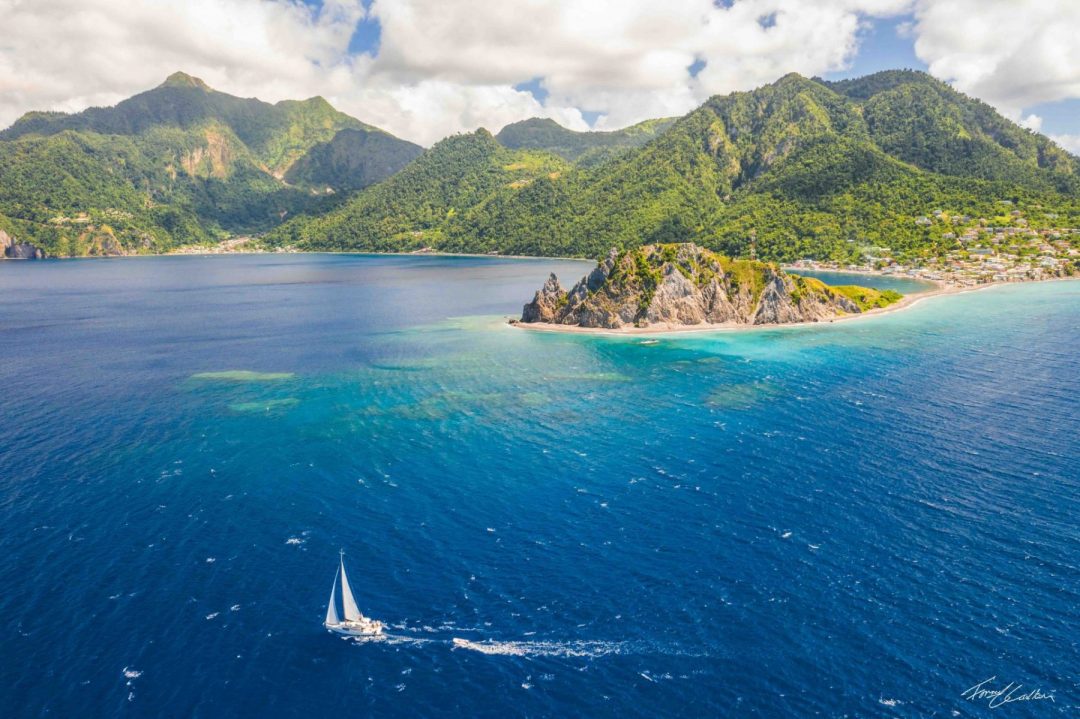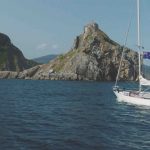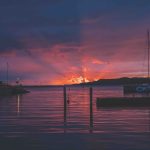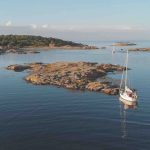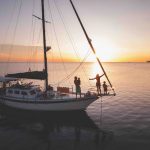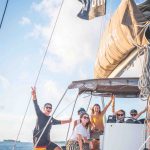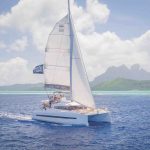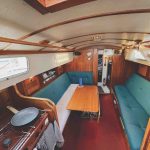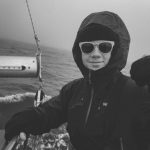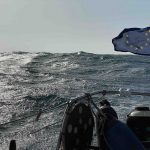This is the story of a young Aussie who sailed through the North Sea, eight-metre tides and the busiest shipping lane in the world only to be (temporarily) arrested in Spain.
As with most good-sailing stories, a man overboard, romance in France and a near catastrophic collision also play their part.
Words & Photos: Forrest Ladkin
The dream
My name’s Forrest, I’m 29 years old from Gerringong on the south coast of New South Wales. Like many Australians, I have a love for the ocean and travelling. Maybe you’re one of these people too. Combining these and sailing the world one day was the logical dream.
At as young as five years old I insisted to my parents that when I grew up, one day, I would be a pirate. Thankfully I outgrew the idea of travelling the world pillaging as I pleased, but the sailing part stuck with me. As I grew up though, I was sucked into the narrative that many people have about becoming an ocean-going skipper, that unless you’ve got loads of money and half a lifetime’s worth of experience, it’s simply too expensive and dangerous to participate in. I resigned myself to the fact that it wasn’t realistic and maybe one day, when I was much older, I could embark on this adventure.
Thankfully, two things happened in my early 20’s that broke this illusion. The first was meeting Julius, a young German/Portuguese surfer traveling Australia in his van. My family embraced him, and we spent a whole summer living together surfing, windsurfing and diving. One day coming out of the water, he mentioned that in a few years’ time he planned to buy a sailboat in the north of Europe and live on it while studying. Assuming he must have a trust fund I didn’t know about, he went on to explain that boats are dramatically cheaper in Europe (and at times, half of what we pay in Australia). He concluded that as long as you didn’t mind living in a relatively small space, you could get a sturdy, ocean-going sailboat for less than a Toyota 4WD here.
Yet still the doubts about becoming a skipper endured… I’d never even been on an actual sailboat and the few sailors I’d come across had big-noted themselves and their exploits, making it sound like only them, with their wealth of experience and skills, could have survived their harrowing voyages. Then, out of the blue I came across a video on YouTube that changed everything. Riley and Elayna were a young Australian couple who had defied the naysayers, bought a yacht in Europe with no experience and started sailing around the world, figuring it out as they went. At the time of their inception eight years ago, channels like theirs (Sailing La Vagabonde) didn’t exist and this story was a revelation. The expression ‘If you can see it, you can do it.’ really rang true for me in this instance, and I have them to thank for pushing me over the edge. The money I had saved for five years as an intended house deposit suddenly had a new cause. I was going to buy a boat in Europe, move onto it and see how far I could sail.
The boat
With Julius’s help we made a shortlist of boats and got ready to make a decision. In the end, instead of going for a modern French production sailboat (which sailed fast, but arguably lacked safety in heavy seas) we opted for an almost 50-year-old, 31-foot Swedish Hallberg-Rassy. We soon learnt HR was one of the most prestigious boat builders in the world, famous for making classy ocean-going sailboats that were slower but built like tanks.
Before I knew it, the paperwork was done, the majority of my life savings were transferred and I was stepping onto a sailboat for the first time in my life. My new home ‘Bellis’ had been meticulously looked after, but still had one major downside. The original 47-year-old Volvo engine was somehow still going. Rusting, leaking oil and (comically) needing to be hand cranked due to a dying starter motor, it was clearly coming towards the end of its long life.
Parts of the Northern European Baltic Sea freeze during the winter and the sailing season was already drawing to a close when I bought Bellis. So Julius and my girlfriend at the time, Tarryn, decided to spend a month sailing through Denmark and Sweden before hauling the boat out for the winter. That way, I could prepare for the big journey the following spring. Tarryn did an incredible job of turning the bare boat into a home that felt warm and vibrant, while Julius and I did our best to learn the systems on the boat and get us sailing. It turns out reading forecasts and actually sailing was surprisingly easy, and no doubt helped by a shared background in surfing and windsurfing. However, when it came to navigating, docking and everything to do with maintaining a yacht, we were woefully ill-prepared. Despite this, the books came out, we researched hard and we soon learned fast from trial and error (lots of trial and error).
I’ll never forget the first time we decided to anchor instead of finding a marina to safely tie up in. Underestimating our passage time, we arrived in complete darkness (mistake #1). It then became apparent we both thought the other was the one who knew how to actually anchor properly. So lacking in confidence of our eventual technique, we put every possible fender around the boat in case we hit something during the night. After this embarrassing first attempt, we soon researched the dynamics of safely anchoring a five-ton sailboat.
Our trio’s time came to an end. The boat was safe in a Swedish boatyard and I had the whole Australian summer to research and plan my trip down the west coast of Europe the following spring. It would be a journey through eight countries, and from what I had been told by other sailors, some of the most difficult sailing around. Compared to the protected and tideless Baltic Sea, infamously huge tides, strong currents and the heaviest shipping traffic in the world lay between me, the warmer weather and prospect of surfing in southern Europe. I was giddy with excitement, but also extremely nervous that I was taking on too much too quickly. Tarryn and Julius wouldn’t be with me this time, so I was either going solo or with whatever friends happened to be traveling Europe at the time.
A scary start in Scandinavia
Finally the European spring came around and I flew into Sweden, only to receive a shock. 8 The ocean was still a dangerously low eight degrees and, more than once, hail and even snow broke out overhead while trying to get the boat ready. In Sweden it’s custom to take your mast off during the winter. This is easy enough, but putting the rigging back on correctly requires some knowledge. I didn’t have the budget for a professional rigger but was blessed with the next best thing. I had met David two years earlier Windsurfing in Peru and he just so happened to live an hour away and knew how to rig a boat (perhaps this shouldn’t have been a surprise, I went on to learn Sweden has the highest number of sailors in the world per capita). While having never done a boat this size before, I’ll always be grateful for David’s optimistic grin as we craned the mast back on and adjusted the rigging.
I’d worked hard for weeks to give Bellis an epoxy bottom coat and fresh anti-foul, and now we’d even managed to rig the boat ourselves. It was a huge relief and sense of accomplishment for someone who was admittedly far from handy on the tools back home. Aside from David, I was touched by how generous the mum and dad owners of the boat yard had been in guiding me to complete my work. They’d even gone out of their way to introduce me to a salty old grandfather who used to own the same model boat as Bellis. He spent hours showing me sides of the boat I never knew about, telling stories of his time sailing the Swedish archipelago and even gave me a tour of his wooden boat workshop. These unplanned interactions were surely one of the most special things about traveling, I reflected.
The afternoon before departure, I was getting ready to attach a forgotten VHF radio antenna to the top of the mast, just as a passing German Shepard and his owner knocked the antenna off the dock and into the water. “Are you the young Australian who’s living on his boat here?” he said. Looking away from the antenna on the bottom of the harbour and up at the silver-bearded Swede, I replied “I am”. Upon learning it was my last night in Sweden, this dad in his 60’s helped me fish the antenna out and insisted on escorting me out to sea with his boat at sunset (so I could test sail Bellis and her engine with a backup vessel close by). If that hadn’t been enough generosity, he then insisted on cooking me and my recently arrived crew home-made Swedish meat balls for our final dinner.
At 3:30am my alarm went off and we began our first ever crossing. It was 100 kilometres to Denmark over the Vikings famed Kattegat Sea and I estimated it would take us around 14 hours. With the help of my two crew we had both sails up quickly and were soon aiming for an empty horizon. My crew were fresh out of Byron Bay High School and at the start of their European gap year. Jarrah (my cousin) and his best mate Archie would join me for a full month, all the way to Amsterdam. At least that was the plan.
The morning started off in high spirits with a golden haze creeping over the horizon. Excitement soon turned to anxiety as the haze developed into a thick unforecasted fog. We’d barely started and already found ourselves in a challenging situation. The stormy spring weather had made it difficult to find a window with favourable wind, so we decided to continue as long as the visibility didn’t drop below 50 metres. The boat wasn’t equipped with AIS (an instrument that allows you to see other vessels plotted on your GPS chart), so we were relying solely on our eyes and ears. It was a freezing and draining first day and sure enough, as we approached the shipping lane 50 kilometres out to sea, a huge tanker loomed out in the distance. My heart was racing but the fog had slowly started to recede, so I knew we had just enough visibility to navigate the lane safely.
As darkness crept in, we passed right by a huge offshore wind farm, which absolutely dwarfed our little boat. Right on schedule we floated up to the Danish coastline and the first Carlsberg’s of the trip were enjoyed. Later we would come to find out that while we had been crossing, a fast ferry to the south near Copenhagen had come flying out of the same fog and hit a sailboat, virtually splitting it in two. Fog was suddenly much scarier than high winds and rough seas.
Continue reading Forrest’s story through the link below!
https://www.yumpu.com/en/document/read/68592591/sb-issue58-digital
